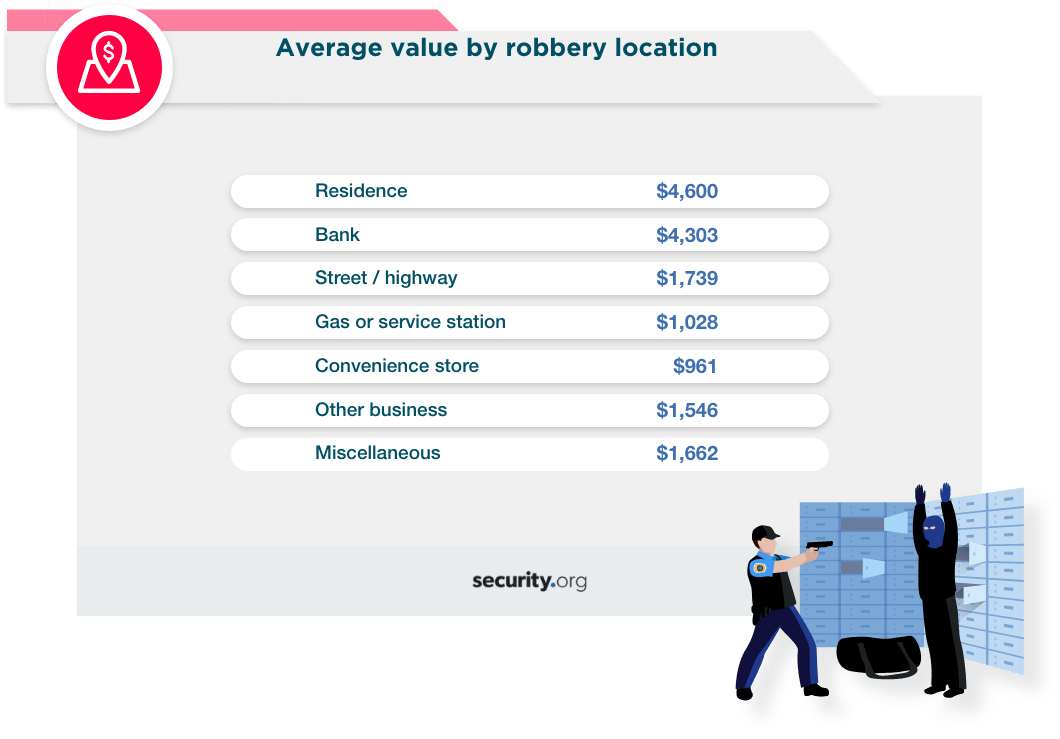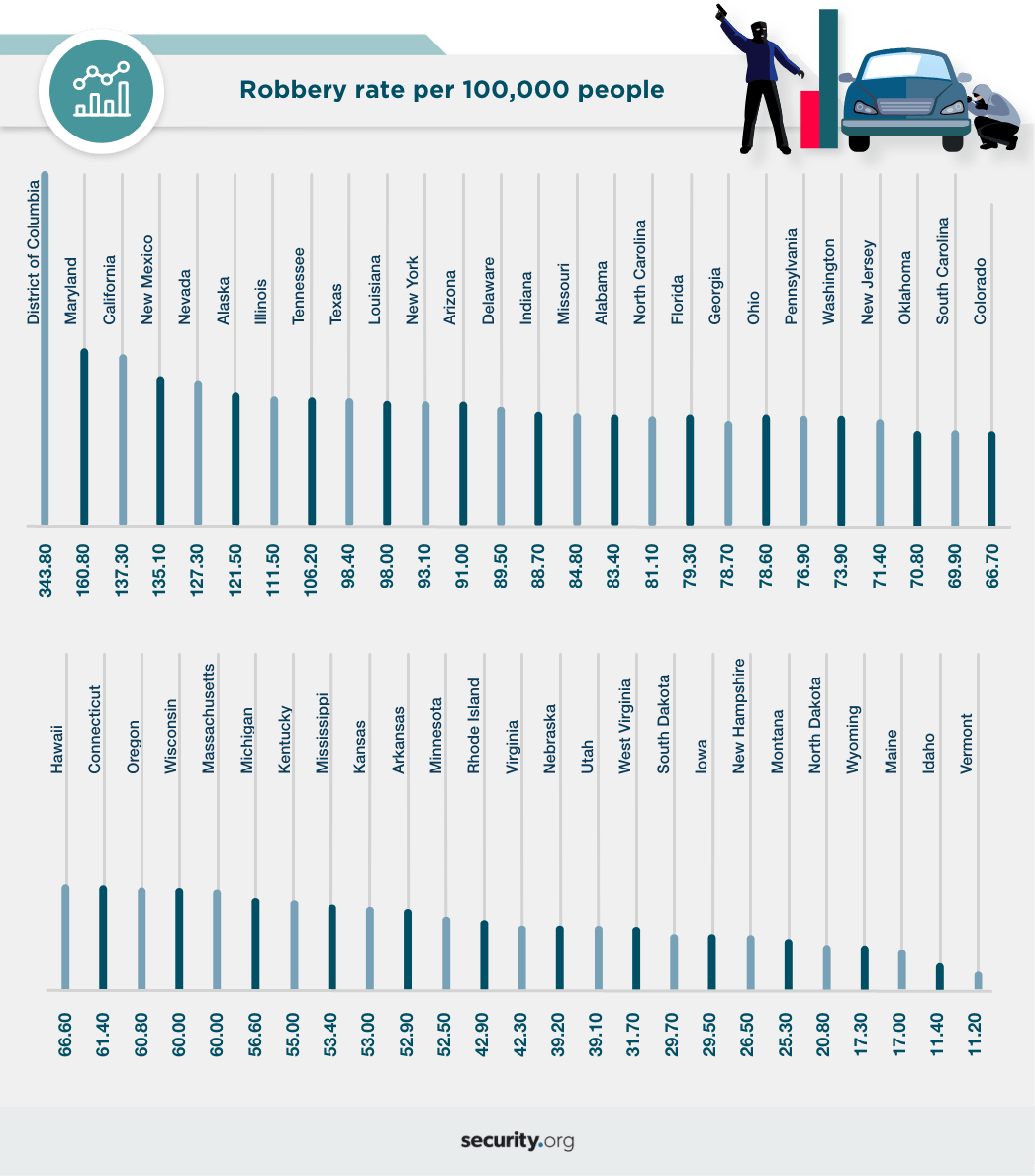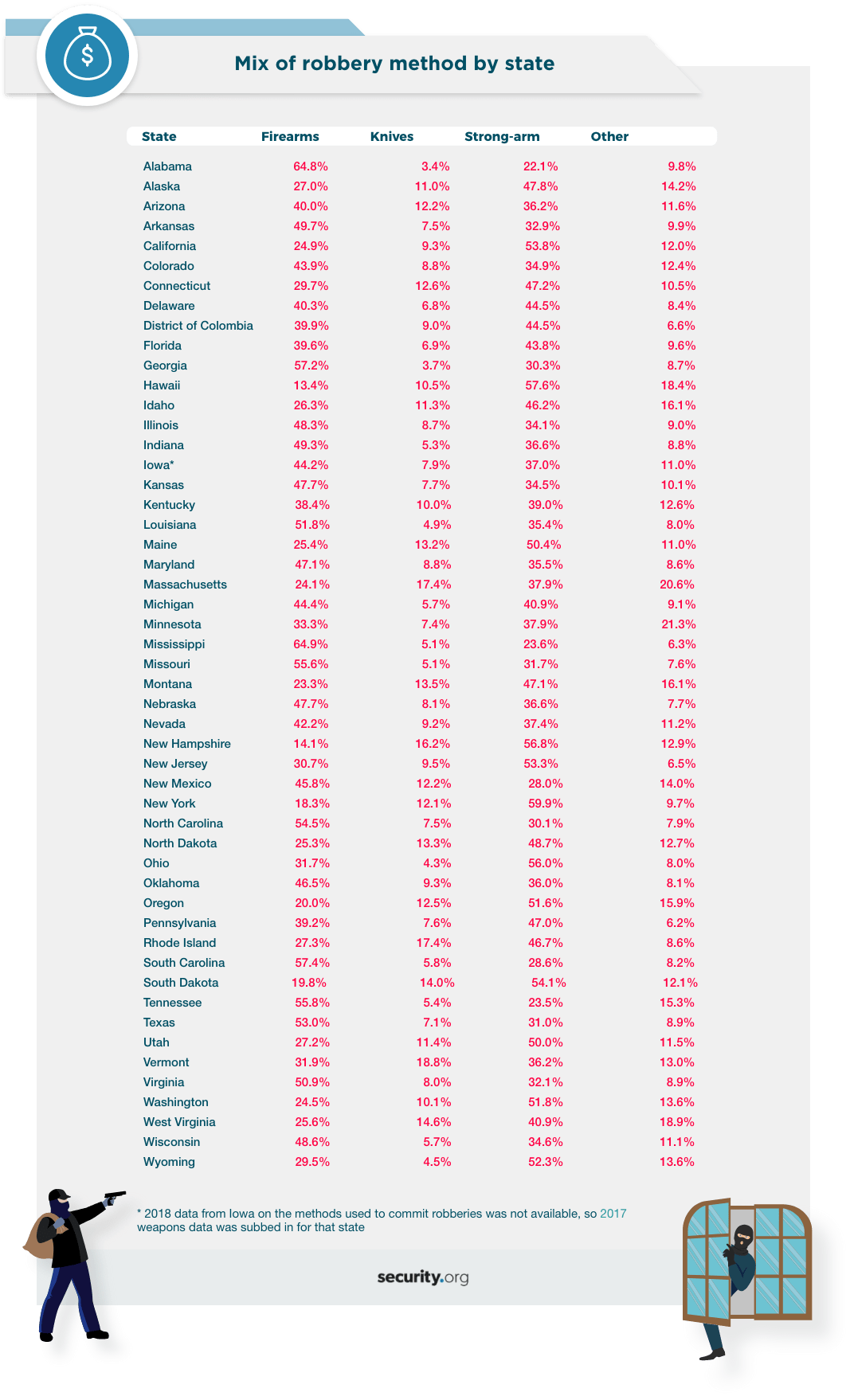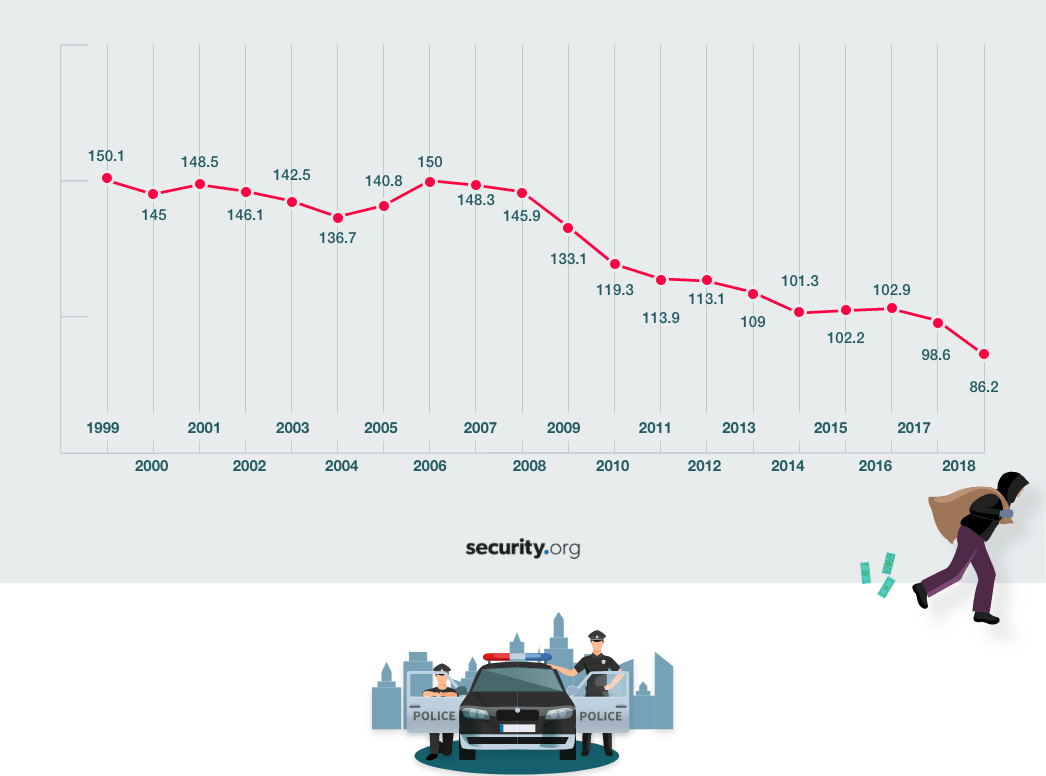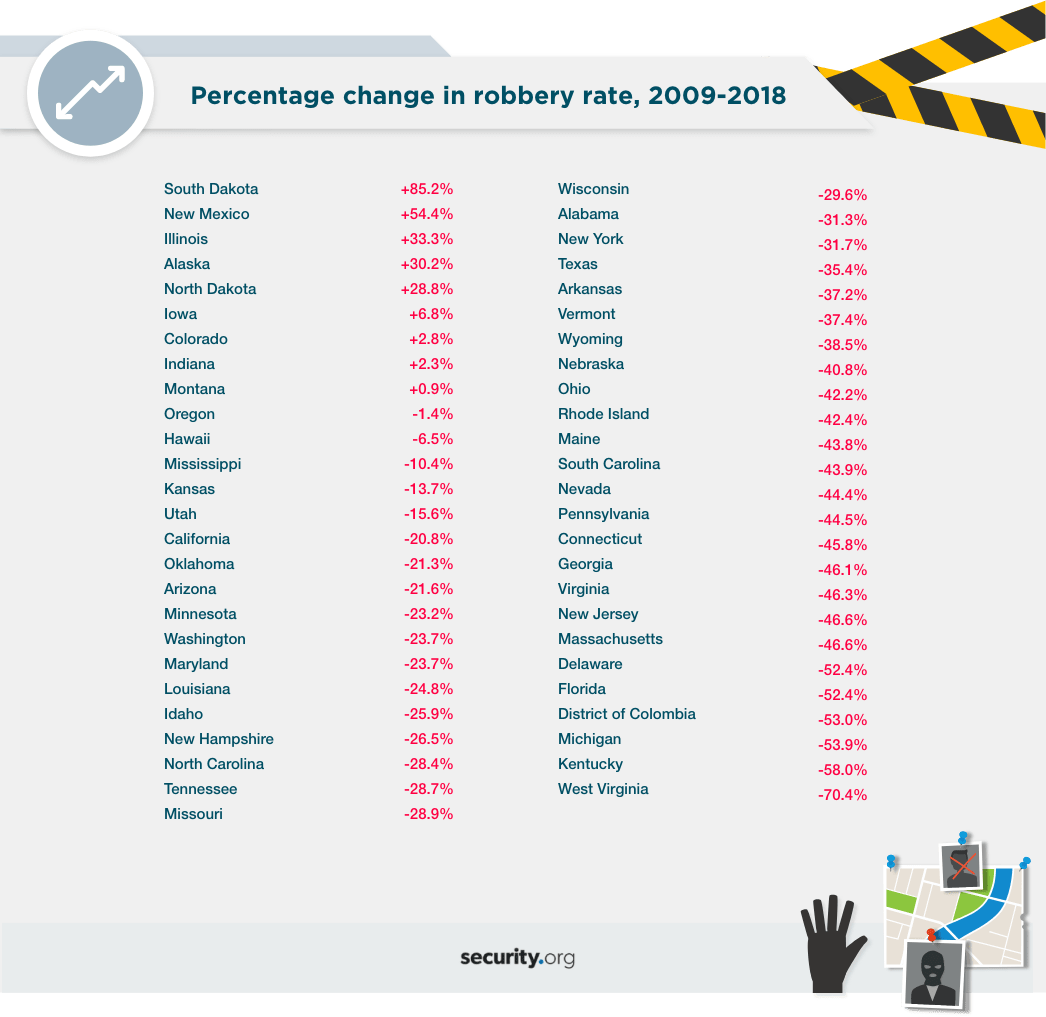Which Americans Are at Highest Risk of Robberies?
Like most crimes in the United States, robbery rates have fallen dramatically over the past two decades. In fact, FBI data shows that reported robberies declined year-after-year in 14 of the past 20 years. Over that two-decade span, robbery rates have dropped by more than 42.6%.
In the past decade, the robbery rate has fallen significantly. It’s one of the largest declines among all reported crime categories. Only burglary rates have dropped faster during the same period.
Most crime rates have fallen over the past decade, with the exception of the rate of rapes (+6.2%) and the rate of murders and manslaughters (no change). Robbery has fallen by 35.2%, aggravated assault is down 6.8%, larceny theft has fallen by 22.8%, and motor vehicle theft has decreased by 11.7%. Each of these crimes has seen its rate fall over the past 20 years, led by a 51.2% decline in burglaries.
The declining robbery rates, however, are no reason to get comfortable. Robbery is still the second-most common type of violent crime, next only to aggravated assault. Robber impacts Americans at a population-adjusted rate of 86.2 per 100,000, which is still a concerning number.
On top of that, robbery tends to cost its victims more than larceny theft, which is the most common crime in the U.S. According to FBI data, the average value taken during a robbery is $2,119, which is nearly double compared to larceny ($1,153). Robbery is not the costliest, but it’s right up there with burglary ($2,799) and auto theft ($8,407).
While robberies are on the lower end of the scale in terms of overall value, where the robbery occurs often dictates how much money the thief gets away with. Robberies of homes and banks are by far the most lucrative for criminals.
About a third of robberies occur on the street or highway. Approximately 20 percent take place at commercial establishments like gas stations and convenience stores. Around 17 percent occur inside residences. By comparison, the majority of burglaries (over 60 percent) take place at residences.
While robbery has become less common in recent years, the likelihood of being robbed depends on where you live. Today, 19 states plus the District of Columbia have higher robbery rates than the rest of the country. Let’s take a closer look at how common robbery is in each state. We’ll also break down what types of weapons are used and how crime has changed in each state over time.
Where Are Rates Highest?
The District of Columbia has the highest robbery rate by a significant margin. Taking the District out of the equation, robbery is most common in California. New Mexico, Maryland, and Illinois are not far behind. The lowest robbery rates are found in Maine, Vermont, New Hampshire, Idaho, and Wyoming.
Regionally, robbery rates are highest in the West, with an overall regional rate of 106.6 per 100,000, by far the highest among the regions. The Midwest had the lowest regional robbery rate at 73.6 per 100,000.
What Weapons Are Used?
As opposed to theft, larceny, and vehicle theft, which are property crimes, robbery is a type of violent crime. To be considered a robbery, the incident must involve violence or threat of violence, with or without the use of weapons.
Approximately 36 percent of robberies involve a firearm or the threat of one. About 9 percent involve criminals using knives or other cutting instruments. However, about 42 percent of robberies are strong-arm robberies, which is when an attacker uses their body, such as hands, fists, or even teeth.
It’s important to note that an actual theft need not have been completed for an incident to be considered a robbery. For instance, a person fleeing a store with merchandise in-hand who, when confronted by a security guard, punches the guard, drops the merchandise and flees has committed a robbery even though they didn’t actually make off with anything valuable.
The use or threat of firearms in robberies is generally highest in the South and parts of the Midwest. Several states like Louisiana, Missouri, and Tennessee, report that over half of robberies involve firearms. Meanwhile, Northeastern states tend to have higher rates of knife-related robberies. We found that states like Vermont and Massachusetts had higher percentages. States with major urban centers like New York and California lead the way in strong-arm robberies. In both states, over 45 percent of robberies involved no weapon beyond physical force.
While guns and knives are the most popular types of non-bodily weapons used, the “other” category is an interesting one that includes things like explosives, pepper spray, acid and brass knuckles, among others.
How Have Things Changed?
Nationally, the robbery rate has fallen from 150.1 per 100,000 in 1999 to 86.2 per 100,000 in 2018, a 20-year drop of 42.6%. Here’s a closer look at the robbery rate by year for the U.S.:
Most crime rates have fallen over the last decade, but the declines are not as dramatic when looking at the past two decades. Still, it’s clear that Americans have become generally safer from most property crimes over the past 10 years.
The legacy definition of rape specifies forcible rape; a revised definition includes any penetration of the vagina or anus with any body part. Under the new definition, the rape rate is about 10 points higher, but those statistics only go back to 2013, so for the purposes of an apples-to- apples comparison, we’ve included the data for the outdated definition.
Several states have seen their robbery rates fluctuate. Some have experienced increases, while others have recorded significant decreases. Robbery rates in Alaska and North Dakota have gone up in recent years. West Virginia and Connecticut have dropped significantly.
The states have also seen changes in weapon use during robberies over time. For instance, some Midwestern states have seen an increase in the use of guns during robberies. We also noticed some Western states have had a decline in the use of knives and other cutting instruments.
Robberies today are far less common than they were even just a decade ago. That might not provide much comfort to victims. Still, whether you have experienced or are likely to experience a robbery is determined in large part by where you live. Many states have low robbery rates. Most others are continuing to make progress.
About This Story
Our analysis of robbery data used figures from the FBI’s annual Crime in the United States reports. The bureau released its complete data for 2018 in the fall of 2019. We have included links to several tables so you can see the hard numbers for yourself, and if you want to dig down even further, you can access nearly a quarter-century of crime data here.
Fair Use Statement
If you’re interested in sharing the analysis or images on this page with your audience, simply provide a link back to the URL of this page. Everything on this page can be shared for noncommercial uses.


